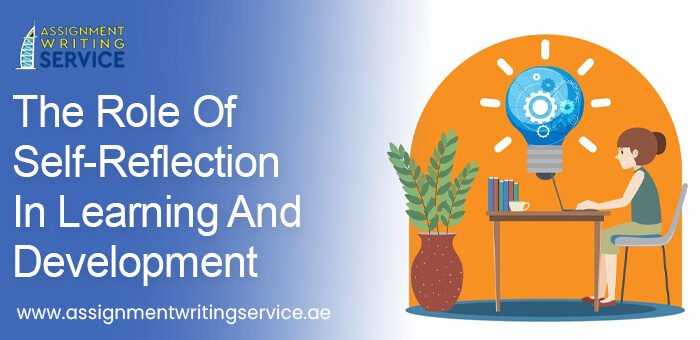
The Role of Self-reflection in Learning and Development
Main Body:
In learning, self-reflection entails analyzing one’s own learning style. It suggests that we can never acquire the understanding required to reinforce positive behaviors and rectify negative ones if we don’t reflect carefully on how we learn. As a result, this cognitive process of self-reflection not only aids students in improving learning outcomes but also promotes self-regulated learning, a cycle of learning that entails organizing academic tasks, employing progress monitoring techniques, assessing the results, and applying the knowledge gained to inform subsequent assignments. A crucial but frequently disregarded component of education is self-reflection. Although professors frequently urge their students to reflect on their own learning, they rarely provide them with guidance on how to do so most successfully. As we already know, a crucial component of our professional development as educators is teacher reflection. You can generally find excellent possibilities to learn how to do that through TESL instruction. However, students’ needs are comparable. Without self-reflection, neither educators nor students can perform to the best of their abilities.
The Value of Self-Reflection in Learning
High reflective individuals are more likely to be motivated, and independent in the way that they ‘learn’, being self-critical and accepting of themselves. In addition, he or she is receptive to critique as well as different mindsets. It may not generally be difficult to carve out the opportunity and space for reflection, however, it is an indispensable piece of your improvement as a scholarly pioneer. It very well might be somewhat troublesome from the get-go, yet with training it will become more straightforward. The art of reflecting on mistakes and lessons that are learned from previous events is a kind of self-reflection. It is like looking into a mirror but with your brain! As a result, self-reflection allows us to realize our strengths and identify opportunities for improvement. First, let us think about fun activities that you do like riding a bicycle. “Wow, I did that so well!” is what you may think. That is you think back on your abilities. It gives you a positive feeling and motivates you to keep trying! But being self-aware goes beyond bragging about how wonderful you are. To also ask yourself, “Hmm, what can I do better?” is important. Perhaps you had a couple of bike falls. You could decide to feel better by telling yourself, “Next time, I’ll balance better!” Self-analysis enables us to grow from our errors. We can determine how to make things right by reflecting on what went wrong. That’s how we improve upon things even further!
Let’s now discuss school. Have you ever performed below your desired level on an exam? Rather than dwelling on your sorrows, consider what transpired. Perhaps you became sidetracked or didn’t study enough. Try studying more or finding a quiet area to concentrate the next time. Educators even use Self-reflection! “Did my students understand?” can I improve as a teacher?” It advances your learning and helps them become great educators! Self-reflection has no limitations up to athletics or academia. It is utilized for many purposes! Perhaps you’re assisting your parents in the kitchen or studying to play an instrument. Rethinking your actions allows you to get better. Either by yourself or with another person, you can reflect. It’s enjoyable to discuss what you’ve learned with loved ones! Ideas can be exchanged, and you can both develop. So, young people, the next time you do something, stop and consider it. What achieved success? What areas need improvement from you? Being able to reflect on ourselves can help us become the finest versions of ourselves, like having superpowers! Moreover, Continue learning and reflecting!
How to Put Self-Reflection into Practice
Self-reflection facilitates faster information absorption for students. However, how might self-reflection be incorporated into our teaching? Make self-reflection a regular practice by using these CIPD assignment writing services helpful pointers.
Contemplation Breaks
Scheduling time for contemplation is the first step in promoting it. Make learning include reflection on a frequent basis to help it become second nature. It only takes five minutes to reach higher-level conclusions during a reflection pause. Active and quiet periods are incorporated into the daily timetable of many classrooms. While active time is used for group work and other learning activities, silent time is used for introspection.
Location
Online and in-person reflection are equally powerful. Reflection is unaffected by distance. This is excellent news for programs involving digital professional development and adult education.
Modeling
Pupils pick up behavior from their teachers. Set an example for students to follow if you want them to reflect more. Incorporate it into your work processes and assist students in the process of reflection.
Sharing
One excellent technique to link information is through introspective, quiet thought. Aloud reflection is an additional method. Give students five minutes to think about a project or lesson, and then give them an additional five minutes to share out loud. As a result, when students gain knowledge from one another, even more information synthesis is encouraged.
Journals
Writing in a journal and self-reflection go hand in hand. Give students some time to jot down their ideas. According to Cheap CIPD Assignment Help, this enhances memory retention and develops writing abilities. Encourage your kids to create pictures or mind maps in their journals as well. Encourage students to share ideas and trade diaries to make it more sociable.
Talks with People
Sharing within the class is fantastic, however, some students find it awkward to speak up in front of others. “Think, Pair, Share” interviews conducted on one help students overcome their shyness and become more comfortable interacting with people while absorbing information.

Leave a Reply